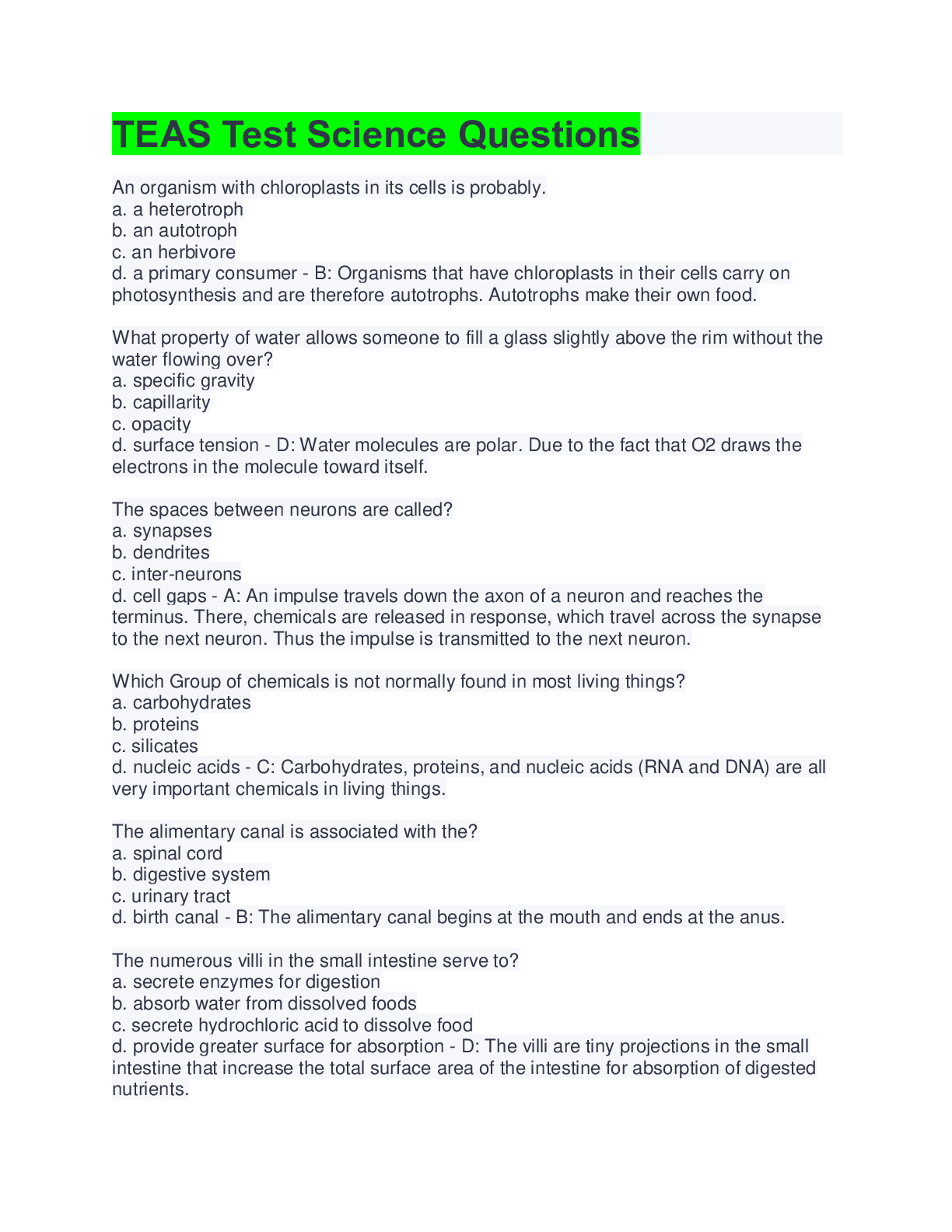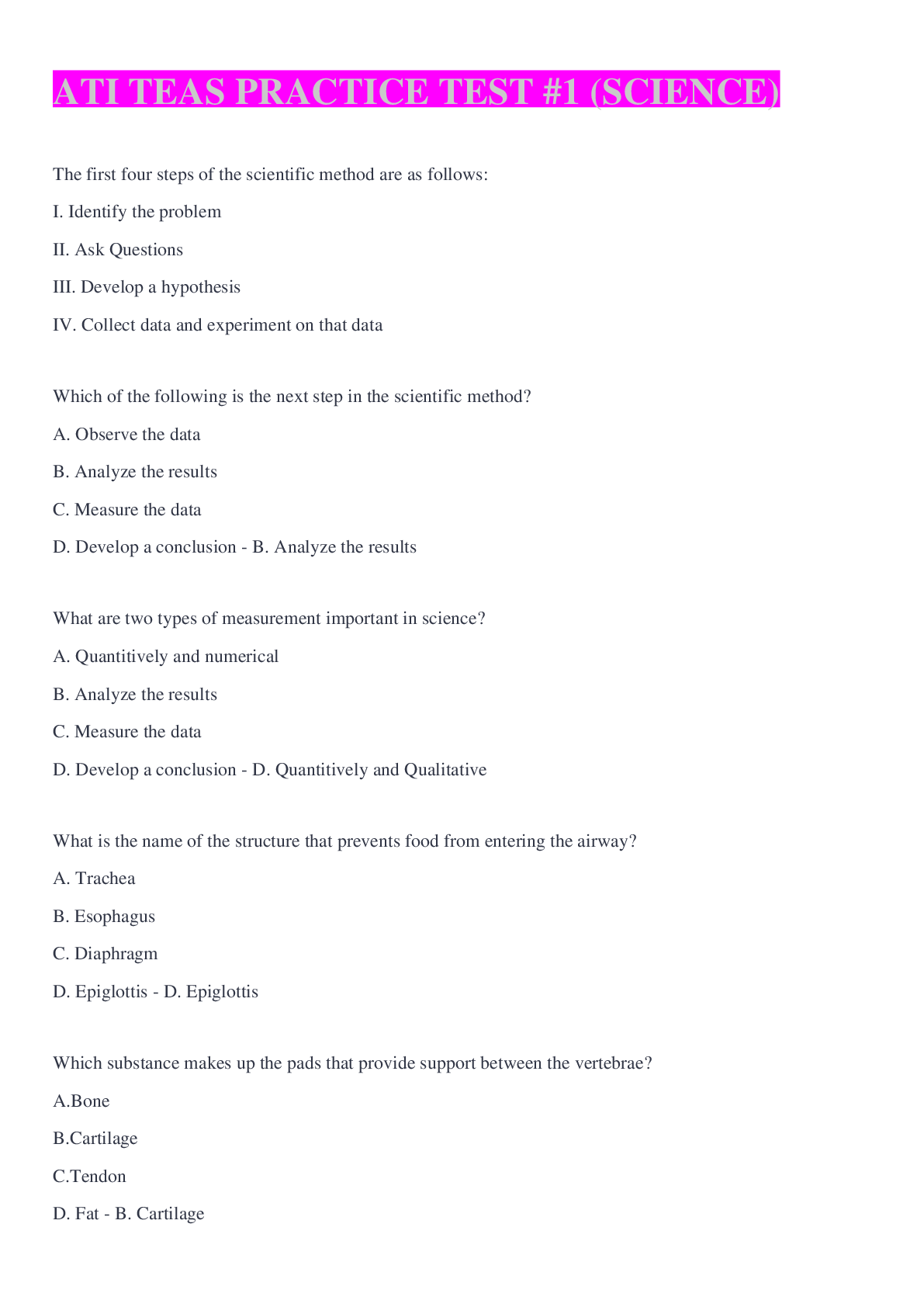Nutrition > EXAM > SCI 228 61343 Nutri, Health and Wellness wLab Mid Term | Questions and Answers/ 100% correct guarant (All)
SCI 228 61343 Nutri, Health and Wellness wLab Mid Term | Questions and Answers/ 100% correct guaranteed
Document Content and Description Below
SCI 228 61343 Nutri, Health and Wellness wLab Mid Term Page 1 1. Question : (TCO 1) Vitamins are classified into two groups, and . Student Answer: fat soluble; water soluble microsolubl... e; macrosoluble nutritive; nonnutritive major; trace Instructor Explanation: Chapter 1 Points Received: 4 of 4 Comments: Question 2.Question : (TCO 1) The are a diverse group of organic substances including triglycerides, phospholipids, and the sterols. Student Answer: carbohydrates lipids vitamins proteins Instructor Explanation: Chapter 1 Points Received: 4 of 4 Comments: Question 3 Question : (TCO 1) What element makes protein different from carbohydrate and fat? . Student Answer: Carbon Hydrogen Nitrogen Oxygen Instructor Explanation: Chapter 1 Points Received: 4 of 4 Comments: Question 4 Question : (TCO 1) Which of the following is an example of disease that is directly . caused by a nutritional deficiency? Student Answer: Anemia Cancer Osteoporosis Heart disease Instructor Explanation: Chapter 1 Points Received: 0 of 4 Comments: Question 5.Question : (TCO 1) Jane consumed a breakfast that contained 85 grams of carbohydrate, 20 grams of protein, and 18 grams of fat. How many kilocalories did Jane eat at breakfast? Student Answer: 492 kilocalories 582 kilocalories 917 kilocalories Instructor Explanation: 1,107 kilocalories Chapter 1 Points Received: 4 of 4 Comments: Question 6 Question : (TCO 1) Which of the following nutrients is organic? . Student Answer: Minerals Water Protein Both minerals and water Instructor Explanation: Chapter 1 Points Received: 0 of 4 Comments: Question 7 Question : (TCO 2) are inorganic nutrients that are not broken down by . the human body or destroyed by heat. Student Answer: Vitamins Minerals Proteins Fats Instructor Explanation: Chapter 1 Points Received: 4 of 4 Comments: Question 8 Question : (TCO 2) The percent daily values (%DV) on food labels are based on the: . Student Answer: DRIs. RDIs. DRVs. all of these Instructor Explanation: Chapter 2 Points Received: 4 of 4 Comments: Question 9.Question : (TCO 2) The standard used to estimate the daily nutrient needs of half of all healthy individuals is: Student Answer: EAR. AI. RDA. UL. Instructor Explanation: Chapter 1 Points Received: 4 of 4 Comments: Question 10 Question : (TCO 2) The dietary standard that has been established regarding . nutrients about which more research is needed to determine human requirements is the: Student Answer: DRI. RDA. AI. UL. Instructor Explanation: Chapter 1 Points Received: 4 of 4 Comments: Question 11.Question : (TCO 2) Which federal agency conducts the National Health and Nutrition Examination Survey (NHANES) and the Behavioral Risk Factor Surveillance System (BRFSS)? Student Answer: USDA (United States Department of Agriculture) CDC (Centers for Disease Control and Prevention) ADA (American Dietetic Association) NIH (National Institutes of Health) Instructor Explanation: Chapter 1 Points Received: 4 of 4 Comments: Question 12.Question : (TCO 2) Which two pancreatic hormones are responsible for maintaining blood glucose levels? Student Answer: estrogen and testosterone neuropeptide Y and leptin insulin and glucagon bicarbonate and HCl Instructor Explanation: Chapter 2 Points Received: 4 of 4 Comments: Question 13 Question : (TCO 3) What is chyme? . Student Answer: ulcerations of the esophageal lining healthy bacteria of the small intestine mixture of partially digested food, water, and gastric juices substance that allows for the emulsification of dietary lipid Instructor Explanation: Chapter 3 Points Received: 4 of 4 Comments: Question 14 Question : (TCO 3) Responding to the presence of protein and fat in our meal, . cholecystokinin (CCK) signals the gallbladder to release a substance called: Student Answer: lipase. pepsin. chyme. bile. Instructor Chapter 3 Explanation: Points Received: 4 of 4 Comments: Question 15.Question : (TCO 3) Bob eats his breakfast and his GI tract will now begin the process of digesting and absorbing the nutrients from this meal. What is the order in which each of the organs of the GI tract will work to achieve this process? Student Answer: mouth: esophagus: small intestine: stomach: large intestine mouth: esophagus: stomach: small intestine: large intestine mouth: stomach: esophagus: small intestine: large intestine mouth: stomach: esophagus: large intestine: small intestine Instructor Explanation: Chapter 3 Points Received: 4 of 4 Comments: Question 16 Question : (TCO 3) Bicarbonate is released into the duodenum during the process of . digestion. Why? Student Answer: to neutralize the acidic chyme to activate hormonal release of bile to digest fats/oils to lubricate the villi of the small intestine Instructor Explanation: Chapter 3 Points Received: 4 of 4 Comments: Question 17 Question : (TCO 3) Which large vessel transports absorbed nutrients to the liver? . Student Answer: portal vein pulmonary vein aorta subclavian vein Instructor Explanation: Chapter 3 Points Received: 4 of 4 Comments: Page 2 1. Question : (TCO 4) Which of the following is NOT characteristic of type 2 diabetes? Student Answer: arises most commonly during adulthood insulin resistance or insensitivity often associated with obesity the least common form of diabetes Instructor Explanation: Chapter 4 Points Received: 4 of 4 Comments: Question 2.Question : (TCO 4) Yogurt is tolerated better than milk by many lactase-deficient people because: Student Answer: yogurt has no lactose. bacteria in yogurt help digest the lactose. it has a thicker consistency. yogurt is acidic. Instructor Explanation: Chapter 4 Points Received: 4 of 4 Comments: Question 3 Question : (TCO 4) Which of the following carbohydrates is the end product of . photosynthesis? Student Answer: glycogen galactose lactose glucose Instructor Explanation: Chapter 4 Points Received: 4 of 4 Comments: Question 4 Question : (TCO 4) Which of the following BESTdescribes the glycemic index? . Student Answer: an individual's glucose/insulin ratio in a fasted state the amount of insulin required to metabolize 100 grams of glucose the glucose content of a given food the extent to which a given food raises blood glucose and insulin Instructor Explanation: Chapter 4 Points Received: 4 of 4 Comments: Question 5.Question : (TCO 4) Which of the following ethnic groups has the LOWEST incidence of lactose intolerance? Student Answer: Asians African Americans Caucasians Hispanics Instructor Explanation: Chapter 4 Points Received: 4 of 4 Comments: Question 6 Question : (TCO 4) Peggy Sue's doctor wants to screen her for reactive . hypoglycemia. If her doctor's suspicions are correct and Peggy Sue does have reactive hypoglycemia, what would you expect her blood glucose concentration to be at approximately TWO HOURS after she had begun her glucose tolerance test? Student Answer: elevated as compared to a normal individual depressed as compared to a normal individual normal; two hours after consuming the glucose load, her blood concentrations will be no different from those of a normal individual. Instructor Explanation: Chapter 4 Points Received: 4 of 4 Comments: Question 7 Question : (TCO 4) Insulin is synthesized and released by the: . Student Answer: brain. liver. pancreas. gallbladder. Instructor Explanation: Chapter 4 Points Received: 4 of 4 Comments: Question 8 Question : (TCO 4) Major fructose sources include: . Student Answer: milk and cheese. nuts and honey. fruits and vegetables. breads and cereals. Instructor Explanation: Chapter 4 Points Received: 0 of 4 Comments: Question 9.Question : (TCO 1-6) The proper steps developed for canning foods ensures that all endospores of are eliminated when followed carefully. Student Answer: Salmonella Clostridium botulinum Giardia intestinalis Campylobacter jejuni Instructor Explanation: Chapter 18 Points Received: 4 of 4 Comments: Question 10 Question : (TCO 1-6) Which of the following is an example of a persistent organic . pollutant? Student Answer: mercury GMO sulfite coal tar Instructor Explanation: Chapter 18 Points Received: 4 of 4 Comments: Question 11.Question : (TCO 1-6) In which of the following environments does Clostridium botulinum flourish? Student Answer: acidic alkaline F > 140F Instructor Explanation: Chapter 18 Points Received: 4 of 4 Comments: Question 12.Question : (TCO 1-6) Which government agency regulates organic farming standards in the United States? Student Answer: Food and Drug Administration United States Department of Agriculture Environmental Protection Agency Centers for Disease Control Instructor Explanation: Chapter 18 Points Received: 4 of 4 Comments: Question 13 Question : (TCO 1-6) Which of the followingBESTdescribes the Delaney Clause? . Student Answer: government action that prevents the intentional addition of compounds that have been shown to cause cancer in animals or humans government recommendation that all predatory fish be tested for mercury before being sold to the consumer list of food additives generally regarded as safe; established in 1958 by the U.S. Congress pending legislation to ban irradiation as a method of food preservation Instructor Explanation: Chapter 18 Points Received: 4 of 4 Comments: Question 14 Question : (TCO 1-6) Which of the following describes lipids? . Student Answer: organic nutrients that are insoluble in water inorganic nutrients that are insoluble in water organic nutrients that are insoluble in fat inorganic nutrients that are insoluble in fat Instructor Explanation: Chapter 5 Points Received: 4 of 4 Comments: Question 15.Question : (TCO 1-6) Pesticides are: Student Answer: chemicals added to food to enhance them in some way. Instructor Explanation: chemicals added to food that help prevent microbial spoilage and enzymatic deterioration. chemicals used in the field and in storage areas to decrease destruction caused by insects and fungus. chemicals produced by microorganisms that harm tissue and elicit an immune response. Chapter 18 Points Received: 4 of 4 Comments: Question 16 Question : (TCO 1-6) Why do fungi rarely cause food infection? . Student Answer: Few species of fungi cause serious illness. Fungal growth makes food look unappealing. Fungal growth makes food taste unappealing. All of these are reasons fungi rarely cause food infection. Instructor Explanation: Chapter 18 Points Received: 0 of 4 Comments: Question 17 Question : (TCO 1-6) Which of the following are the most common form of . pesticides? Student Answer: insecticides herbicides fungicides biopesticides Instructor Explanation: Chapter 18 Points Received: 0 of 4 Comments: Page 3 1. Question : (TCO 5) Which of the following fatty acids is generally solid at room temperature ? Student Answer: Instructor Short-chain Saturated Monounsaturated Polyunsaturated Chapter 5 Explanation: Points Received: Comments : 4 of 4 Question 2.Questio (TCO 5) n : is(are) the key structural component of a cell's membrane. Student Answer: Instructor Estrogen Glycerol Phospholipids Triglycerides Chapter 5 Explanation: Points Received: Comments : 4 of 4 Question 3.Questio n : (TCO 5) Which type of dietary fat is known to elevate blood cholesterol levels? Student Answer: Instructor Saturated Trans Monounsaturated Both saturated and trans Chapter 5 Explanation: Points Received: Comments : 4 of 4 Question 4.Questio n : (TCO 5) To facilitate the digestion of dietary fats, the gallbladder stores and releases a substance known as: Student Answer: Instructor lipase. bile. hydrochloric acid. bicarbonate. Chapter 5 Explanation: Points Received: Comments : 4 of 4 Question 5.Questio n : (TCO 5) Where in the body are the majority of triglycerides stored for future energy needs? Student Answer: Instructor Lipoproteins Beta cells of the pancreas Liver Adipose tissue Chapter 5 Explanation: Points Received: Comments : 4 of 4 Question 6.Questio n : (TCO 5) The two essential fatty acids are: Student Answer: Instructor cholesterol and bile. linoleic and alpha- linolenic acid. butyric and stearic acid. cis and trans. Chapter 5 Explanation: Points Received: 0 of 4 Comments : Question 7.Questio n : (TCO 5) All of the following organs assist in the digestion of lipids EXCEPT the: Student Answer: Instructor liver. large intestine. gallbladder. pancreas. Chapter 5 Explanation: Points Received: Comments : 4 of 4 Question 8.Questio n : (TCO 5) Which of the following is a fat replacer? Student Answer: Phosphate Saccharin Instructor Olestra Trans fat Chapter 5 Explanation: Points Received: Comments : 4 of 4 Question 9.Questio n : (TCO 6) The process through which mRNA copies genetic information from DNA and carries it to the ribosome is called: Student Answer: Instructor translation. deamination. denaturation. transcription. Chapter 6 Explanation: Points Received: Comments : 4 of 4 Question 10 Question(TCO 6) . : Which of the following is NOT a major function of protein in the human body? Student Answer: Instructor Maintaining fluid balance Providing energy to the body Growth and maintenance of new tissue Synthesis of hormones Chapter 6 Explanation: Points Received: Comments : 4 of 4 Question 11.Question(TCO 6) The : process of transferring the amine group from one amino acid to another is called: Student Answer: gene expression. Instructor alteration. deamination. transamination. Chapter 6 Explanation: Points Received: Comments : 4 of 4 Question 12.Question(TCO 6) The : specific function of a protein is determined by: Student Answer: Instructor its sequence of amino acids. its length. its three-dimensional shape. its electric charge. Chapter 6 Explanation: Points Received: Comments : 4 of 4 Question 13 Question(TCO 6) . : Protein digestion begins in the . Student Answer: Instructor mouth stomach small intestine pancreas Chapter 6 Explanation: Points Received: Comments : 4 of 4 Question 14 Question(TCO 6) The . : part of the protein molecule that carries nitrogen is the: Student Answer: Instructor acid group. amine group. side chain. hydrogen group. Chapter 6 Explanation: Points 4 of 4 Comments : Question 15.Question(TCO 6) Milk : curdles when lemon juice is added to it. The change that occurs in the protein is called: Student Answer: Instructor denaturation. translocation. transcription. deamination. Chapter 6 Explanation: Points Received: Comments : 4 of 4 Question 16 Question(TCO 6) The . : type of protein- energy malnutrition characterized by a general lack of protein, energy, and nutrients in the diet is called: Student Answer: Instructor marasmus. sickle cell anemia. cystic fibrosis. kwashiorkor. Chapter 6 Explanation: Points Received: Comments : 0 of 4 [Show More]
Last updated: 1 year ago
Preview 1 out of 26 pages
.png)
Reviews( 0 )
Document information
Connected school, study & course
About the document
Uploaded On
Nov 04, 2022
Number of pages
26
Written in
Additional information
This document has been written for:
Uploaded
Nov 04, 2022
Downloads
0
Views
65





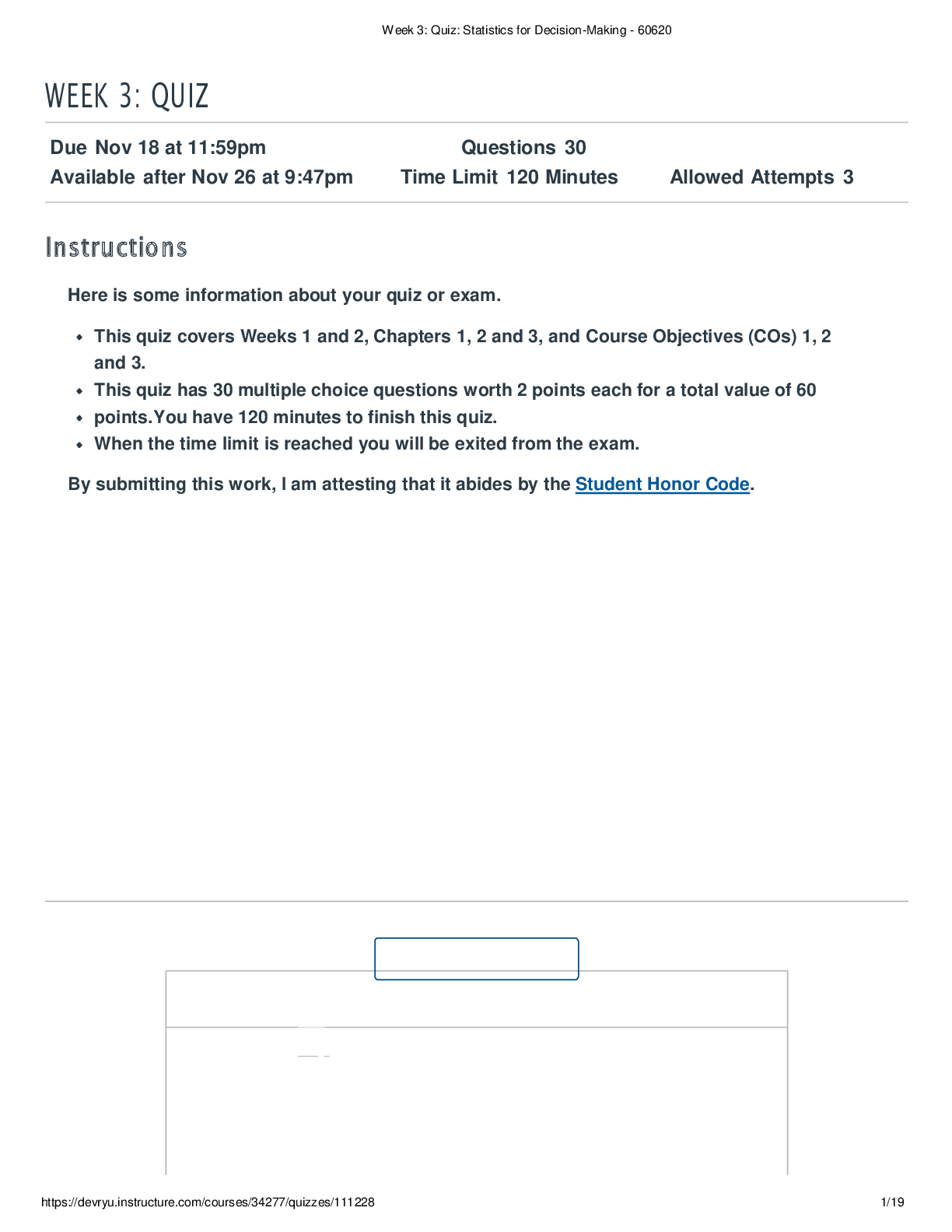

.png)











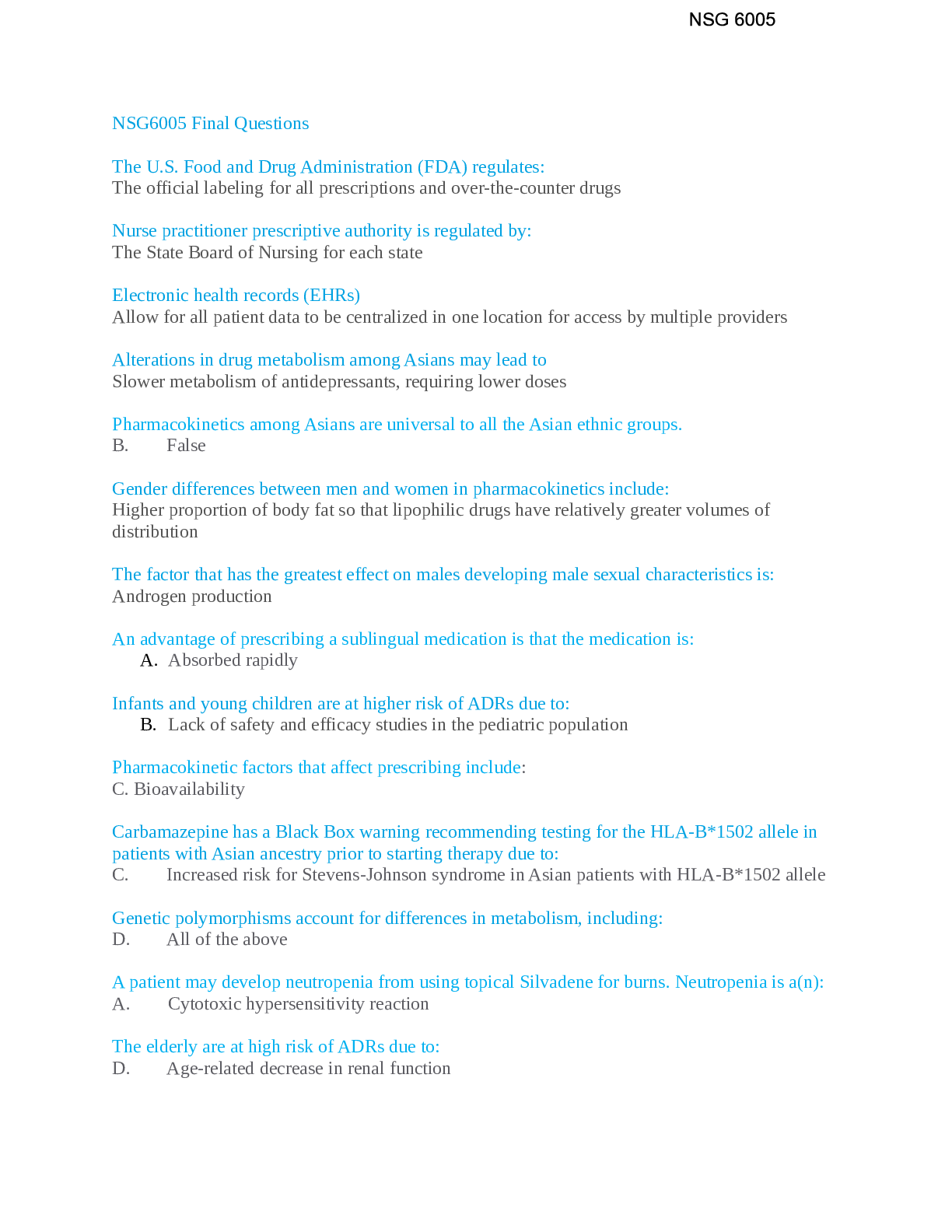
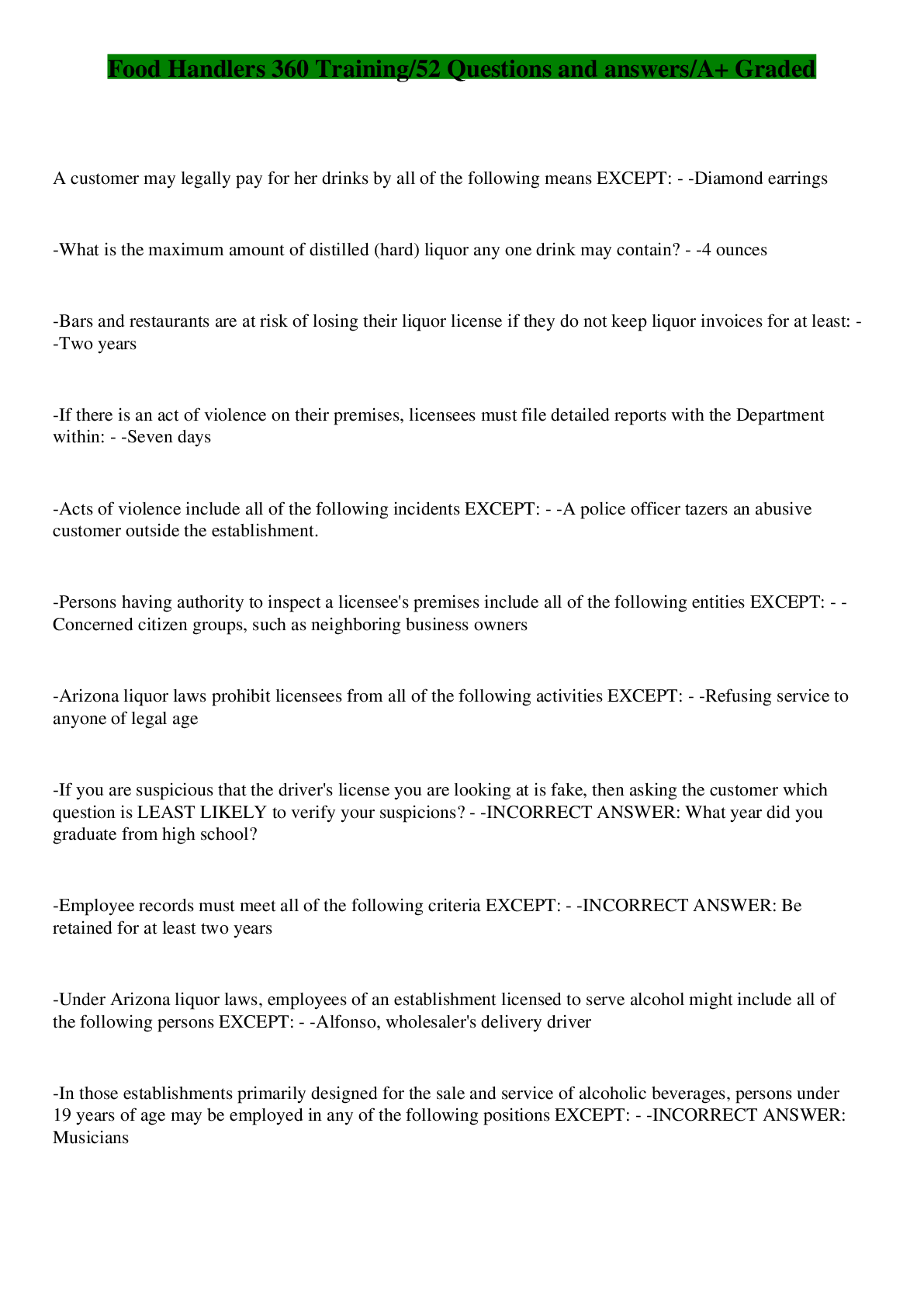
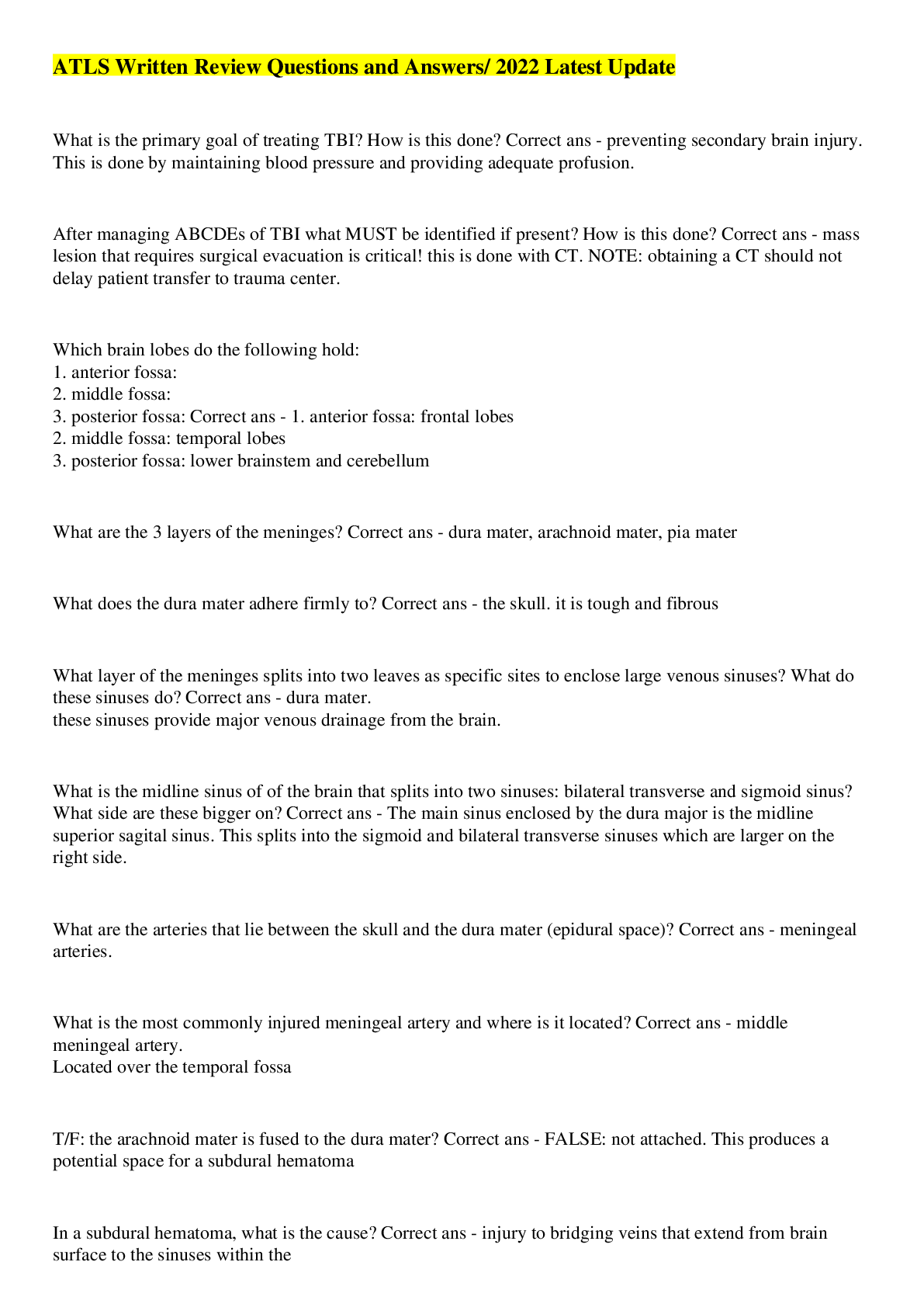
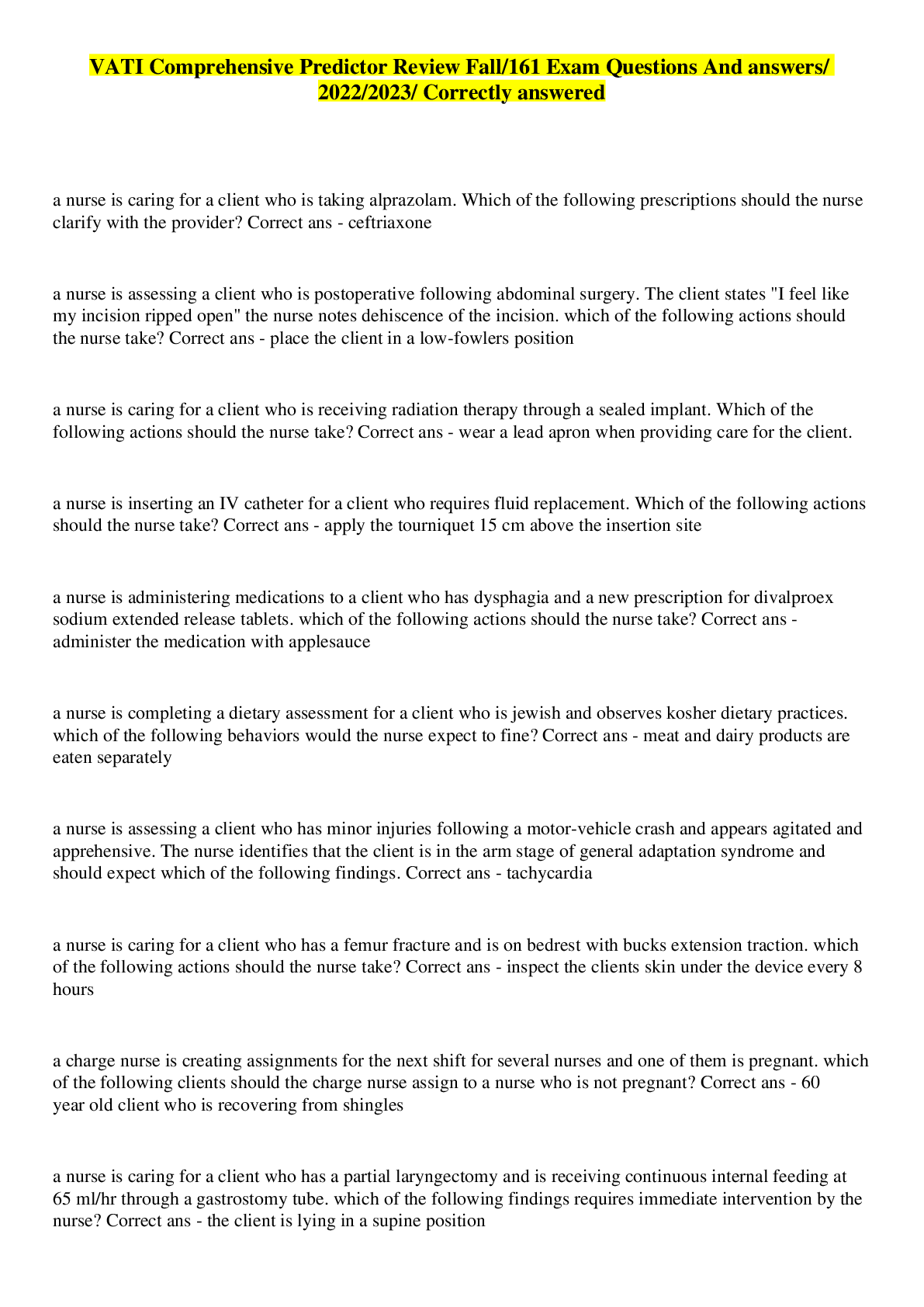
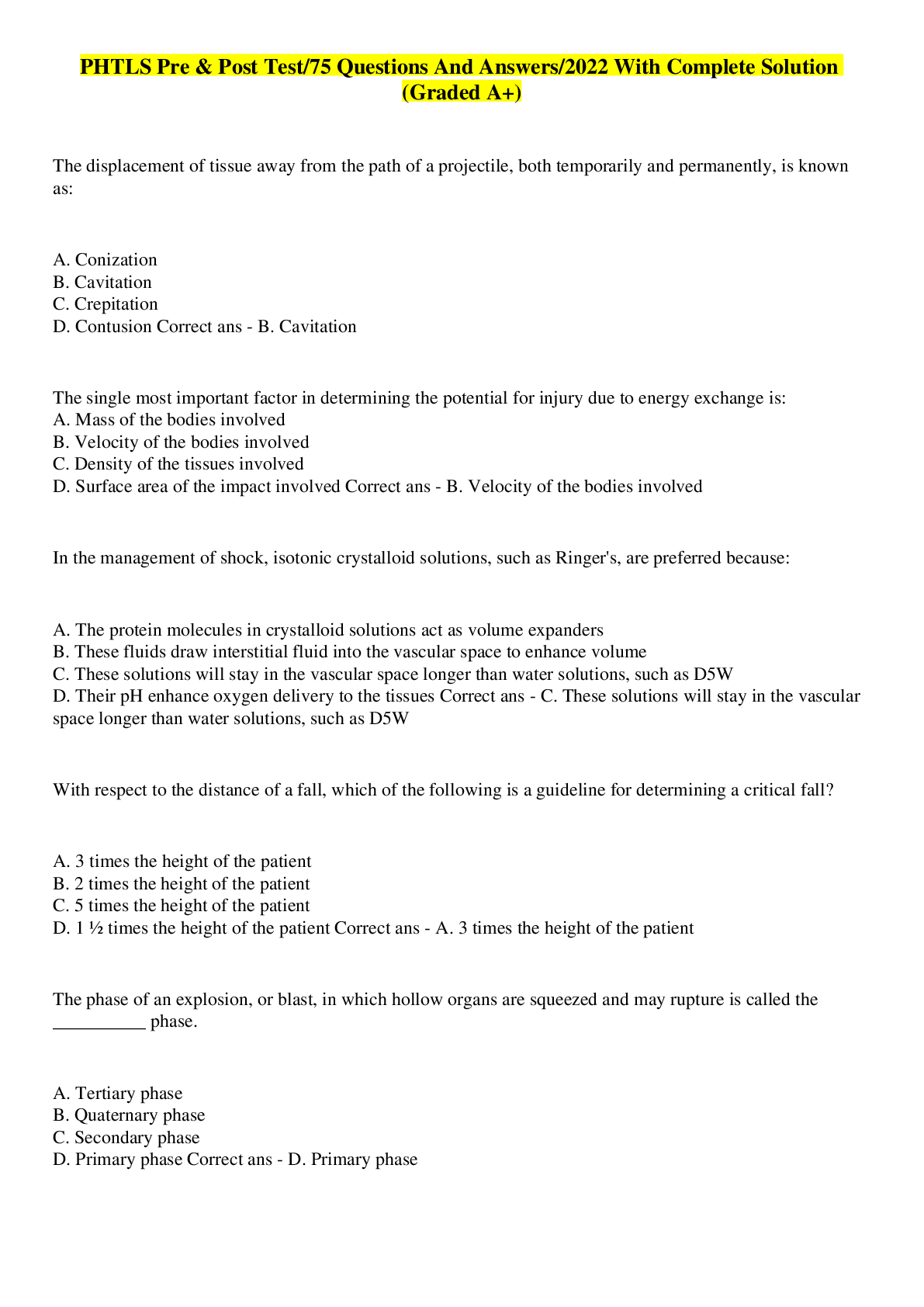
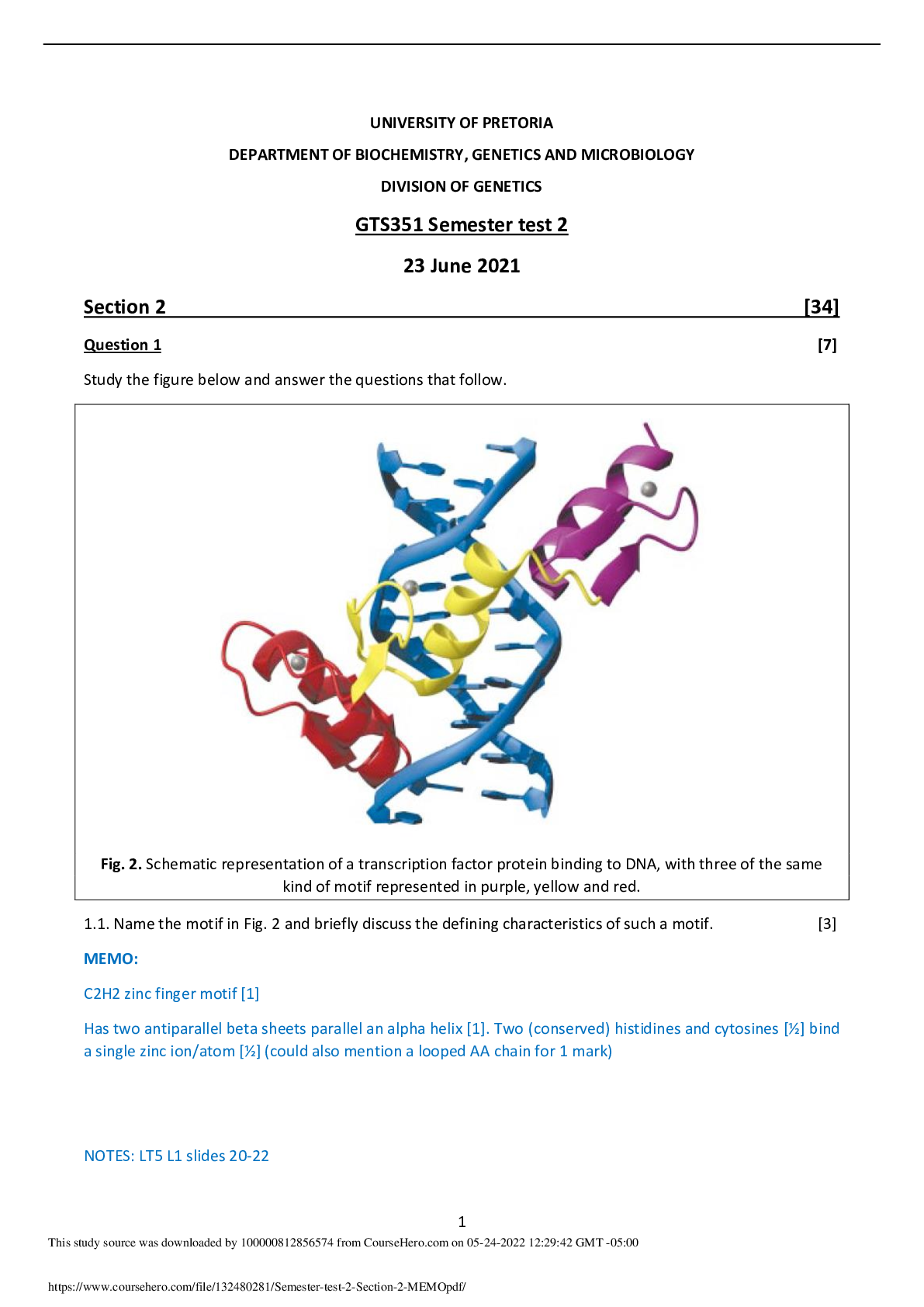
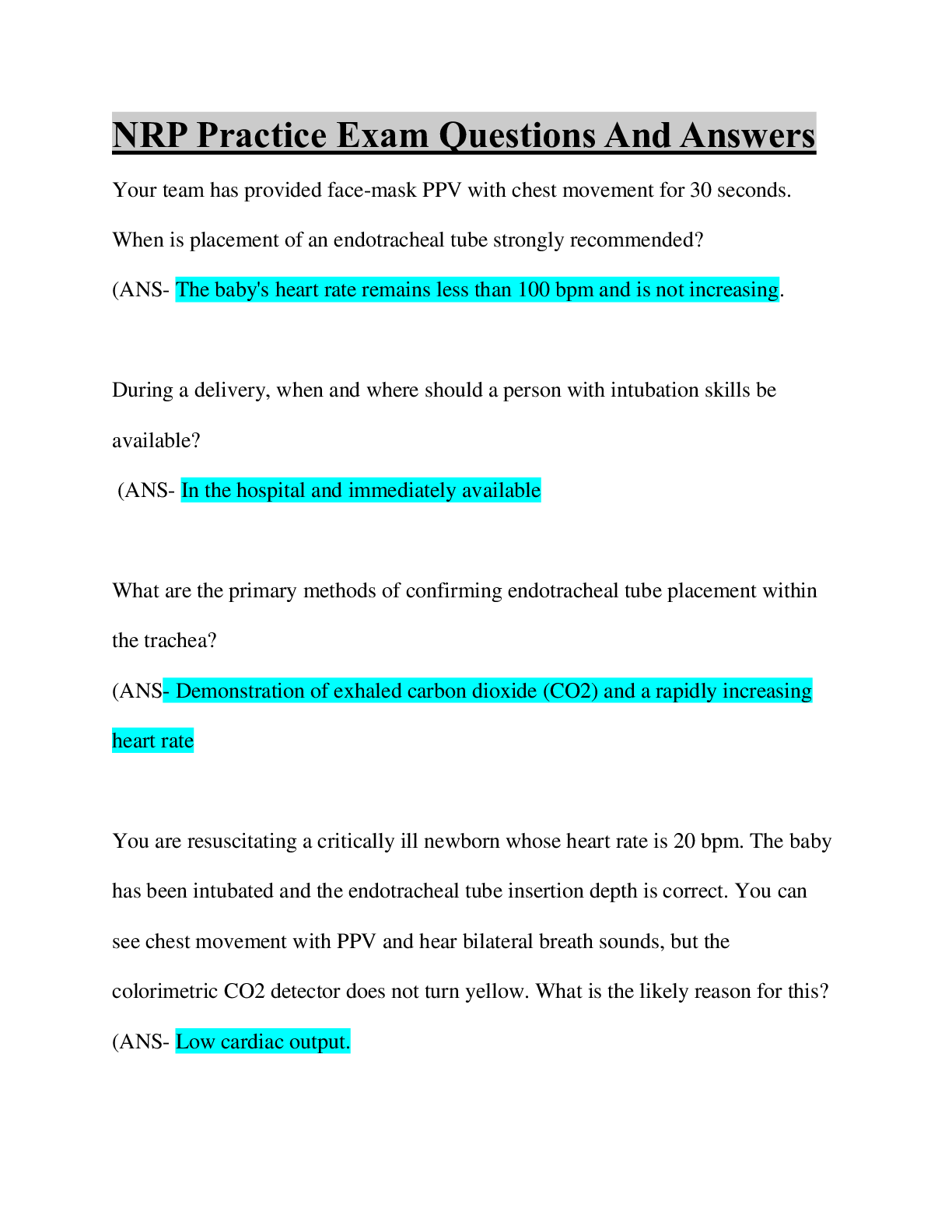
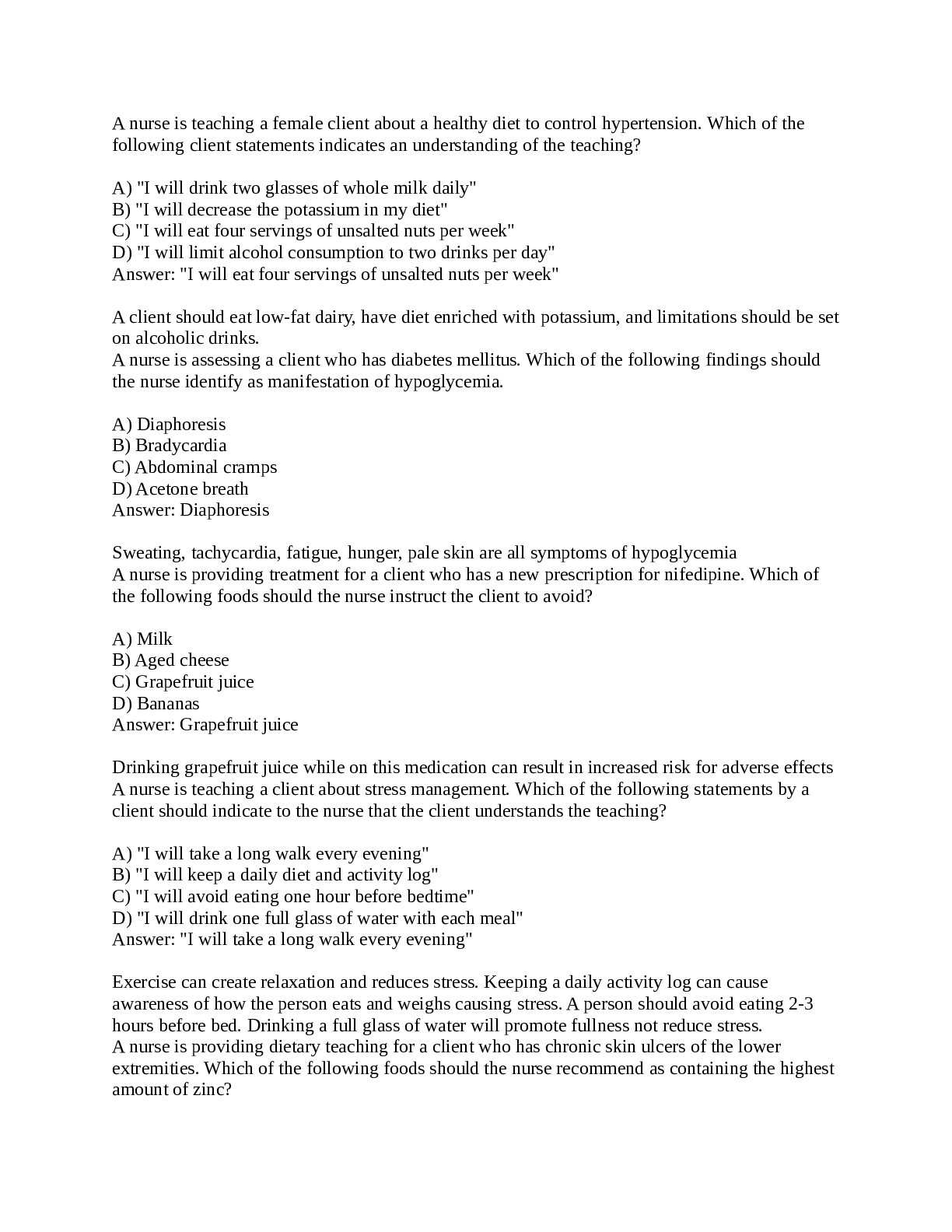
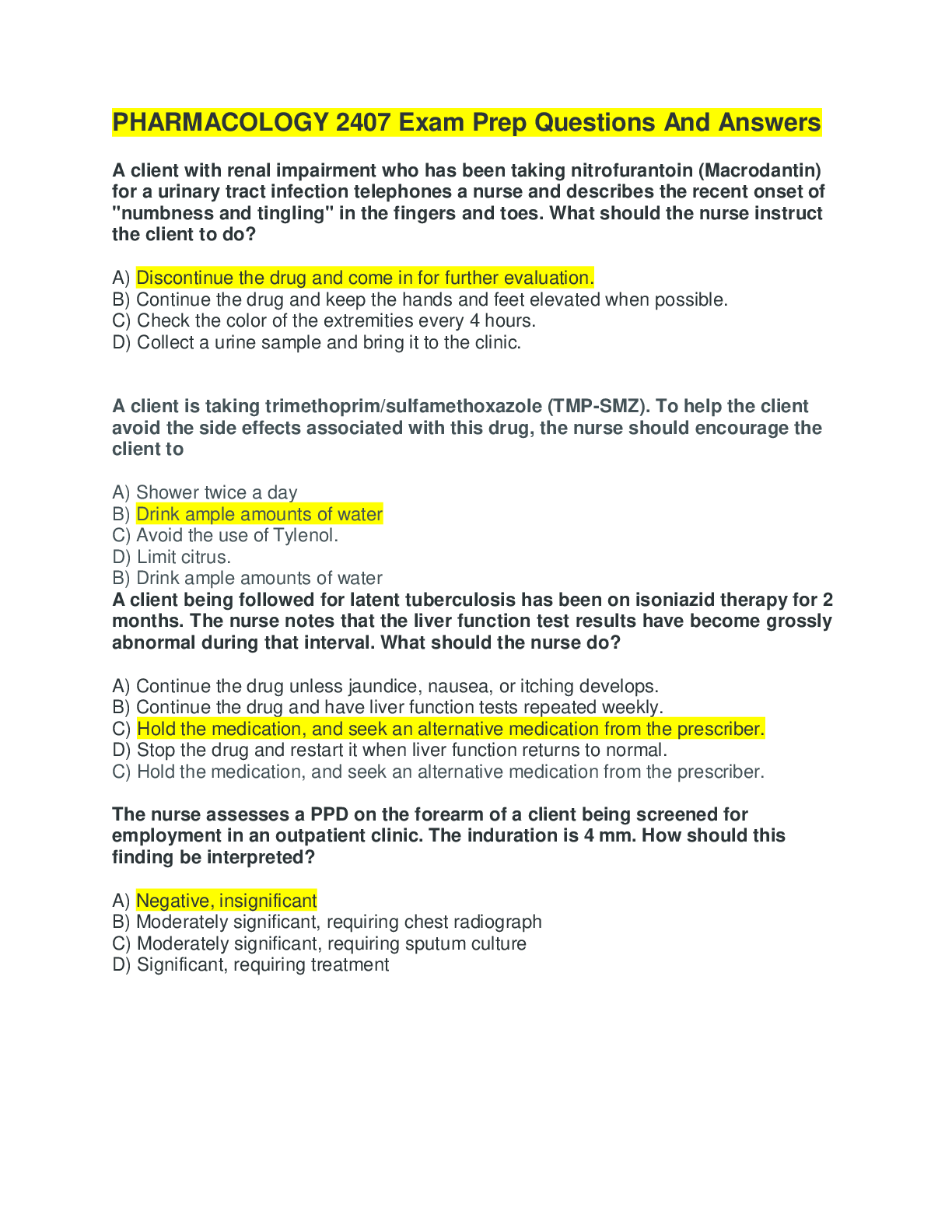
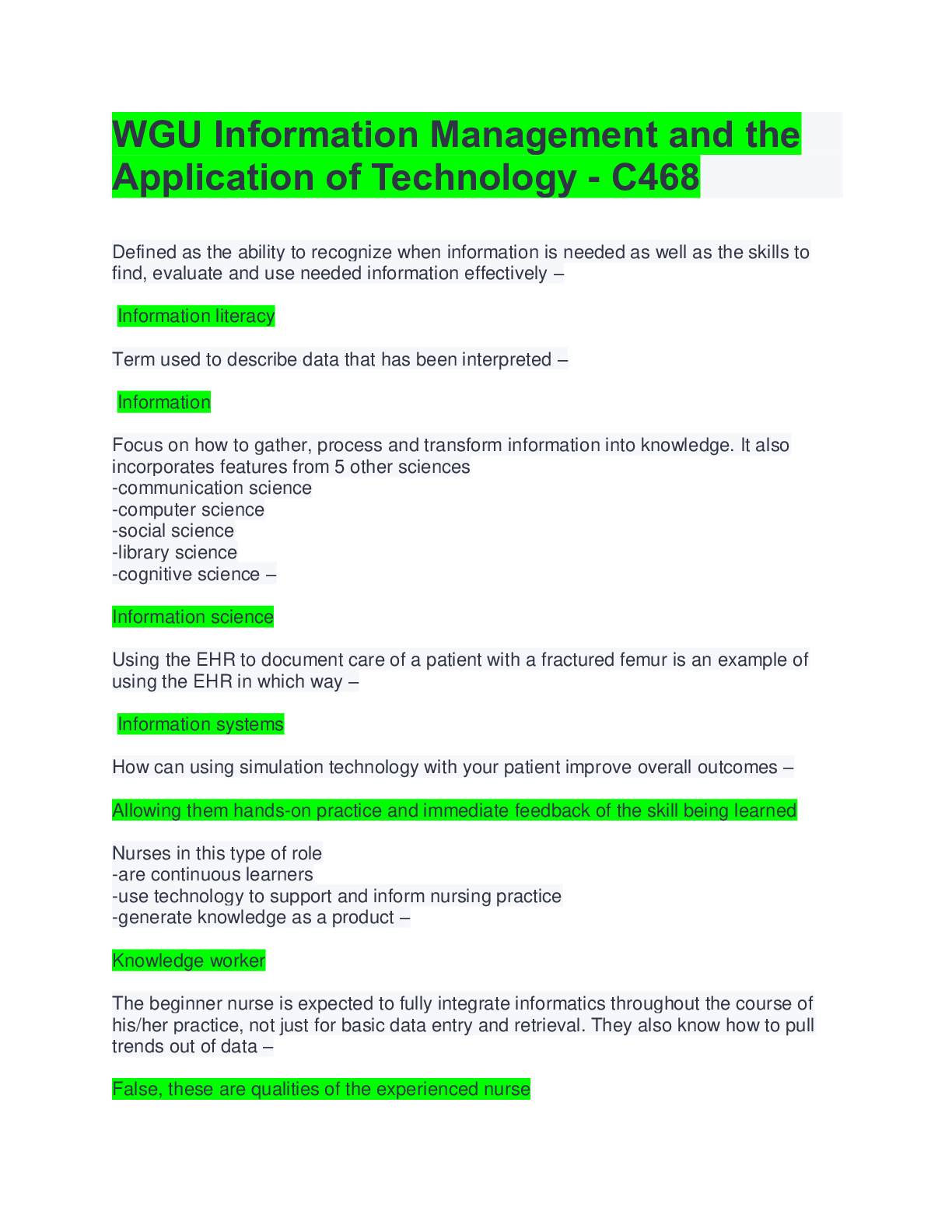
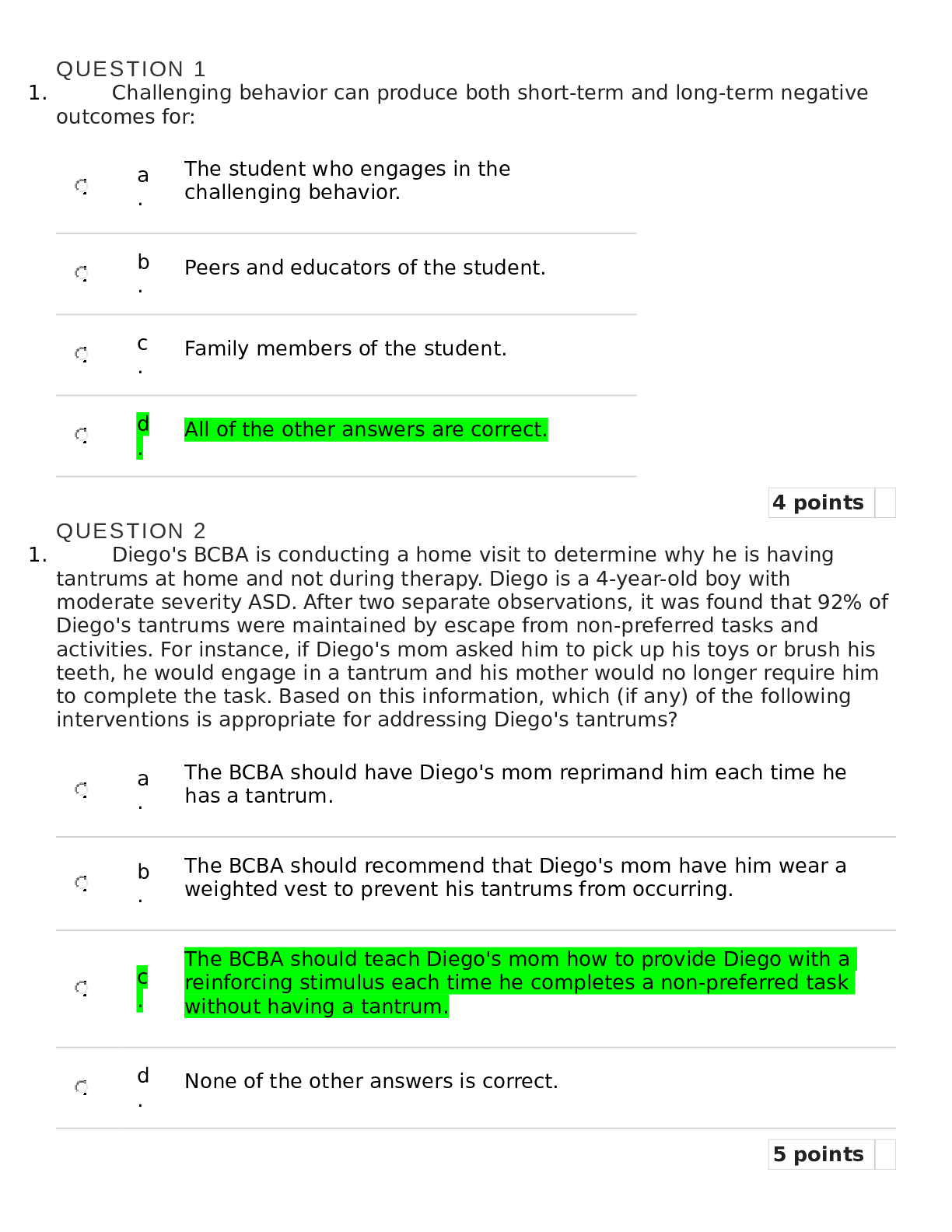

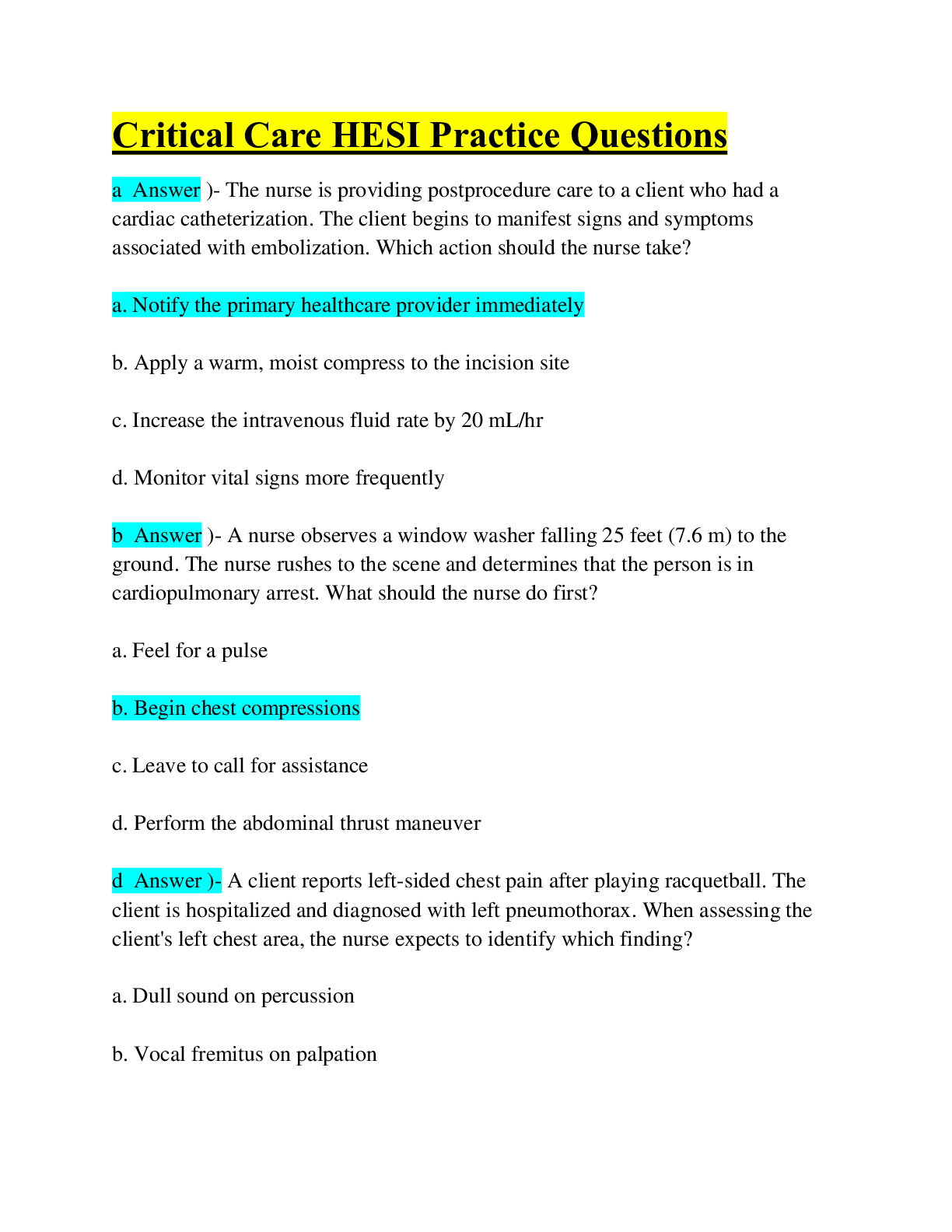
 (1).png)
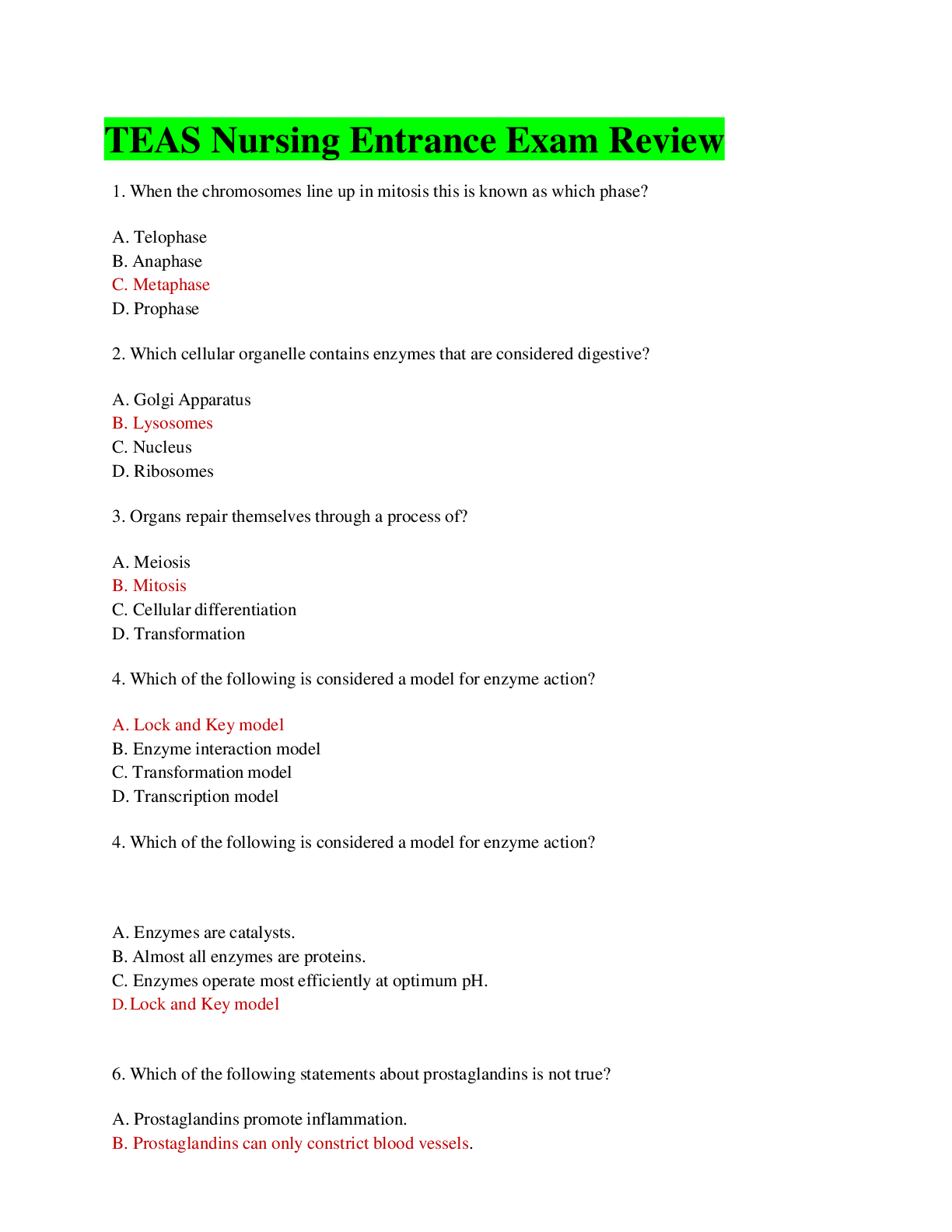
.png)
